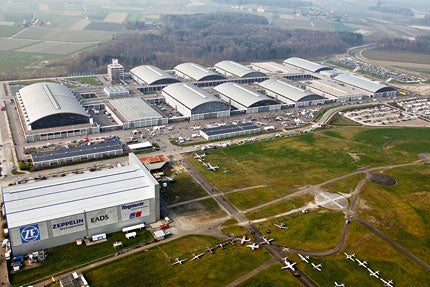 |
For many sport aviation-industry watchers at this year’s Aero trade show—it’s the annual European bash right after our Sun ‘n Fun—the star attraction was Peter Funk’s magnificent FK51 Mustang. This knockout stunner (see my Buyer’s Guide in this issue) drew crowds with its all-composite replication of the original North American P-51’s shiny aluminum skin, right down to 100,000 simulated rivets and screws, including indentations for every single one. (Did squadrons of forest elves pull 24-hour shifts pressing rivet heads into molds?)
I lead with the 70% scale Mustang because it epitomizes Aero, which you can think of as Europe’s aviation Disneyland. Here’s where you see the latest conventional and electric aircraft prototypes and model updates, new power systems and airframe construction methods, avionics advances and so much more.
I’ve never been, but I felt this important gathering gives us a sharp and clear focus on advances in flight we often don’t see Stateside for years—if ever. So I asked my pal Dan Johnson, light-aircraft expert and purveyor of the superb website www.bydanjohnson.com, to be our Aero 2013 tour guide.
Let’s start with Dan’s industry-seasoned view on why we Yanks should pay attention to Aero. After all, don’t we already have our own Sebring, Sun ‘n Fun, Oshkosh and regional aviation gatherings? “This is Europe’s most important air show,” he begins. “I’ve been to 10 of them. That first visit, the largest plane I saw was a Cessna 206. Now, they have jets and GA displays everywhere—but Aero has firm roots as a recreational aircraft event. They call it ‘sport flying’ in Europe, and it’s always been driven by the sailplane community.”
After World War II, the victorious Allies prohibited Germany’s pilots from flying powered aircraft, so sailplane flight grew widely popular, as it had after World War I. To this day, soaring remains a vital mainstay of German civilian flight. Here at home, the general aviation-to-sport aircraft ratio is roughly 80% to 20%, which includes all sailplanes and homebuilts. In Europe, it’s just the opposite: 80% sport to 20% GA!
“We sometimes think of sport flying as a U.S. phenomenon,” Dan continues, “But we’re only one of several active and developing markets that include Australia, Brazil, Europe, China and India.”
The Aero site right at Friedrichshafen’s airport is a massive complex of 11 huge halls, each “the size of a basketball gymnasium,” says Dan, “and every one pretty much filled wall to wall with aircraft.” Each hall has huge doors. Even the big aircraft can taxi up, shut down and be towed to their display space inside. “You get everything from gyroplanes to jets. There’s an entire hall dedicated just to RC model aircraft, which have little presence at U.S. air shows. And get this: Between every hall are restrooms and a restaurant!
“But here’s why Aero is so important,” Dan continues. “The majority of light-sport aircraft sold here and worldwide come from Europe. And Aero is the place to see what’s coming down the pipeline.”
The setting is classic southern Germany eye candy: Across the Bodensee (aka Lake Constance), the Swiss Alps vault into the sky. Storybook-beautiful Austria and Liechtenstein are just down the lake. “It’s also a great place for family or friends who aren’t aviation enthusiasts,” Dan adds.
Friedrichshafen is the historical birthplace (1900) of Germany’s massive Zeppelin dirigibles that sailed the world’s skies in the 1930s. There’s a big Zepp museum there. You can even buy a ride on a modern airship!
Not every aircraft or innovation at Aero will make it to the U.S. or world market. Selling isn’t even the primary motivation for many exhibitors. Of course, visitors do see the latest versions of aircraft that sell in the U.S. But there are one-off versions of wild ideas you’ll never see here. They’re brought out to showcase and share the creative genius of designers and builders. “It’s similar to Oshkosh’s Federal Pavilion and NASA’s display building. You get to see all these cool futuristic ideas people are working on,” Dan says.
Aero’s halls are organized by aircraft types. You’re likely to stumble across things you’ve never seen or heard of, sometimes from unexpected places such as Iran.
Electric flight is always big at Aero. Right inside the main gate, there’s an entire outdoor display of electric and solar-powered aircraft. Evektor introduced its prototype EPOS solely as a proof-of-concept design, yet 10 people offered to buy it on the spot. Eric Raymond displayed his two-seat sailplane-derived solar cell-powered Sunseeker Duo sailplane to get funding for a major flight this year.
A few more of Dan’s highlights: “Peter Funk [designer/producer of the FK aircraft line, including the FK12 Comet LSA aerobatic biplane, FK51 Mustang and several other distinguished aircraft] is the Steve Jobs of sport aviation; he’s always pulling a surprise out of his hat.” Joining the Mustang was Funk’s other magician’s rabbit: a gorgeous replica of the vintage 1930s Bücker131 Jungmann stunt biplane, dubbed the FK131. It will be produced by his FK-Lightplanes Germany.
Another significant debut was Chinese producer Yuneec’s eSpyder, set to make its U.S. push. The ultralight is certified to Germany’s DULV standard, the first electric aircraft to achieve certification. Yuneec will soon sell other electric models in Europe.
Dan was impressed by an Italian mainstay’s major display. “Tecnam’s booth was maybe the biggest of any of the halls. I think they had 15 full-sized aircraft. Two highlights were the new Astore and Snap single-seat aerobatic LSA.”
Another phenomenon we don’t see much of in the States: gyrocopters. “Aero showcases all these gorgeous gyros. Two recent developments: side-by-side, fully enclosed cockpits and the first-ever ballistic parachute for a gyro. The ‘chute deploys through the center of a five-inch tubular rotorshaft.” A surprise: Dan notes that engine giant Rotax claims the gyrocopter sector buys more engines than any other category. “One company, AutoGyro, delivers 300 units a year!”
Exciting developments in engine technology are common at Aero. The FlyEco smart diesel is an 80 hp power plant that burns just seven liters of fuel per hour! The 91.8 hp four-cylinder four-stroke, liquid-cooled flathead engine claims a three gph fuel burn.
Three other LSA that caught his eye: TL Ultralight’s racer-like low-wing tandem LSA Stream, in early development; the Avana Odonata amphibian mockup, which reminded him of the Icon A5 but reportedly will weigh 400 pounds less; and Zlin’s Bobber, which brings the customized motorcycle concept to an established line of Cub-like flivvers.
“Zlin offers 50 customizations: chromed airframe and engine parts, control sticks and rudder pedals, big tires, beautiful leather saddlebags behind the seats, an uncovered fuselage, cool things like that. It’s the Harley of the air,” Dan concludes.
One thing you won’t see at Aero: air show performances. Aero did away long ago with that distraction in favor of static-only display. Dan Johnson’s parting comment should bring cheer to all: “The consensus among many Aero exhibitors: 2013 is showing a much stronger market. I heard the same thing at Sun ‘n Fun. The industry mood is much more positive.”



